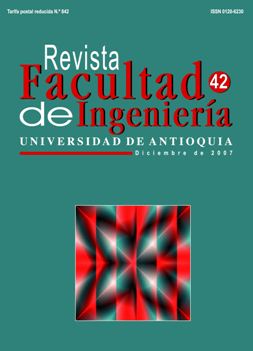Assessment of the susceptibility of lacquered tinplate cans to corrosion in different solutions using electrochemical methods
DOI:
https://doi.org/10.17533/udea.redin.18829Keywords:
Tinplate, electrochemical techniques, corrosion in containersAbstract
Corrosion of lacquered tinplate cans in different solutions was assessed using electrochemical methods. Samples with and without lacquer coating were exposed to different solutions and their susceptibility to corrosion was evaluated using cyclic voltammetry, Tafel curves and electrochemical impedance spectroscopy. The possible formation of a passive layer on the container surface was evaluated according to the kind of hysteresis presented in the first cycle of voltammeter measurements. Tafel plots showed how the behaviour of the tin layer can change from anodic to cathodic depending on the nature of the solution in contact with it, revealing the risk of localized corrosion. The effect of one additive in the solutions on the electrochemical performance containers was evaluated by electrochemical impedance. The impedance showed a deleterious effect of the additive, and corrosion processes appeared more quickly in containers packed with solutions modified with additive.
Downloads
References
R. D. Armstrong, J. D. Wright, “Impedance studies of poly ethylmethacrylate coatings formed upon tinfree steel”. Corros. Sci. 33. 1992. pp. 1529-1539. DOI: https://doi.org/10.1016/0010-938X(92)90031-W
R. D. Armstrong, J. D. Wright, “Impedance studies into the corrosion protective performance of a commercial epoxy acrylic coating formed upon tin plated steel”. J. Appl. Electrochem. Vol. 22. 1992. pp. 795-800. DOI: https://doi.org/10.1007/BF01023720
M. Pourbaix, “Atlas of electrochemical equilibria in aqueous solutions”. Ed. NACE, Houston Texas. 1974. p. 475.
T.P. Murphy, in Uhlig’s Corrosion Handbook, 2th Edition, Ed: R. Winston Revie. 2000. p. 858.
V. K. Gouda, E. N. Rizkalla, S. Abd El-Wahab and E. M. Ibrahim, “Corrosion behaviour in organic acid solutions_I. Tin electrode” Corros. Sci. Vol 21. 1981. pp.1-15. DOI: https://doi.org/10.1016/0010-938X(81)90058-5
A. Amirudin, D. Thierry. “Application of electrochemical impedance spectroscopy to study the degradation of polymer-coated metals”. Prog. Org. Coat. Vol. 26. 1995. pp. 1-28. DOI: https://doi.org/10.1016/0300-9440(95)00581-1
P. L. Bonora, F. Deflorian, L. Fedrizzi. “Electrochemical impedance spectroscopy as a tool for investigating underpaint corrosion”. Electrochim. Acta. Vol. 41. 1996. pp. 1073-1082. DOI: https://doi.org/10.1016/0013-4686(95)00440-8
G. Nascimento, J. L. Dos Santos, C. P. Margarit and O. R. Mattos. “Lacquered tinplate: Corrosion resistance in the function of lacquering conditions”. Electrochim. Acta, Vol. 41. 1996. pp. 1099-1102. DOI: https://doi.org/10.1016/0013-4686(95)00443-2
J. M. Bastidas, J. M. Cabañes, R. Catalá. “Evaluation of prolonged exposure of lacquered tinplate cans to a citrate buffer solution using electrochemical techniques”. Prog. Org. Coat. Vol. 30. 1997. pp. 9-14. DOI: https://doi.org/10.1016/S0300-9440(96)00669-8
J. C. P. White. “Predictive testing of internal coated foods cans”. J. Corrosion Science and Engineering. Vol. 2. 1999. paper 27.
De Micheli L., Barbosa C. A. Andrade A. H. P., Agos-tino S. M. L., “Electrochemical behaviour of 254 SMO stainless steel in comparison with 316 L stainless steel and Hastelloy C 276 in HCL media”, British Corrosion Journal. Vol 35. 2000. pp. 297-300. DOI: https://doi.org/10.1179/000705900101501371
Kok Y. N., A Kid R., Hovsepian P. E., “Tribocorrosion testing of stainless steel (SS) and PVD coated SS using a modifi ed scanning reference electrode technique”, WEAR 259: Part 2 Sp. 2005. pp. 1472-1481. DOI: https://doi.org/10.1016/j.wear.2005.02.049
E.E. Foad El-Sherbini. “Cyclic voltammetry investigation of dissolution of tin in isobutyric acid solution and inhibition effect of some polymers”. J. Electroanal. Chem. Vol. 584. 2005. pp. 167-173. DOI: https://doi.org/10.1016/j.jelechem.2005.02.016
Downloads
Published
How to Cite
Issue
Section
License
Revista Facultad de Ingeniería, Universidad de Antioquia is licensed under the Creative Commons Attribution BY-NC-SA 4.0 license. https://creativecommons.org/licenses/by-nc-sa/4.0/deed.en
You are free to:
Share — copy and redistribute the material in any medium or format
Adapt — remix, transform, and build upon the material
Under the following terms:
Attribution — You must give appropriate credit, provide a link to the license, and indicate if changes were made. You may do so in any reasonable manner, but not in any way that suggests the licensor endorses you or your use.
NonCommercial — You may not use the material for commercial purposes.
ShareAlike — If you remix, transform, or build upon the material, you must distribute your contributions under the same license as the original.
The material published in the journal can be distributed, copied and exhibited by third parties if the respective credits are given to the journal. No commercial benefit can be obtained and derivative works must be under the same license terms as the original work.










 Twitter
Twitter